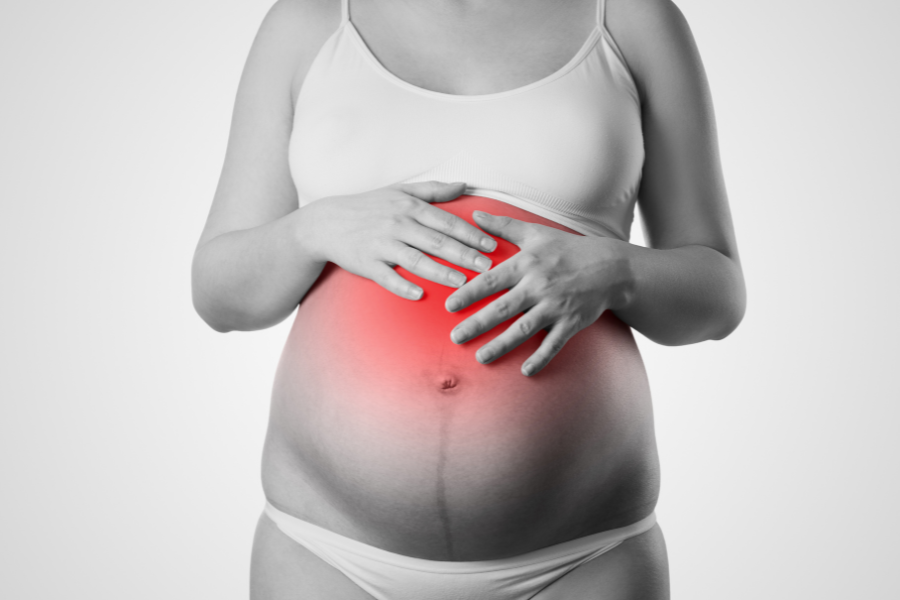When it comes to working out during pregnancy, there are often questions about what is safe and recommended.
One topic that frequently arises is whether wearing a lifting belt during pregnancy is beneficial or potentially harmful.
In this comprehensive exploration, we will delve deep into possible answers to this query and their potential role during pregnancy.
Related Article: How and When to Use Lifting Belts?
What Does a Lifting Belt Do?

Lifting belts, also called weightlifting or back support belts, are specialized equipment designed to support the lower back and core during heavy lifting.
They consist of a wide, thick band that wraps around the waist, aiming to increase intra-abdominal pressure, which stabilizes the spine and core muscles.
Lifting belts help maintain proper posture and reduce the risk of lower back injuries during exercises. Lifting exercises during pregnancy are great; however, taking measures is mandatory.
Benefits of Using Lifting Belts During Pregnancy

Using lifting belts during pregnancy can be a topic of discussion, and some individuals may find them beneficial under specific circumstances.
Here are some points to support the use of lifting belts during pregnancy:
Lower Back Support
Lifting belts can provide additional support to the lower back, which often experiences strain and discomfort during pregnancy.
Enhanced Stability
Maintaining proper form and stability is essential when lifting objects or weights. To reduce the risk of injury, wearing a lifting belt is recommended.
Maintaining Strength
For women who were active weightlifters or engaged in strength training before pregnancy, lifting belts can allow them to continue their routines with reduced risk.
Peace of Mind
Some expectant mothers may feel more confident and secure while exercising with a lifting belt, knowing that they have extra support for their back and core muscles.
DMoose belts can be an ideal choice for you if you are on the lookout for a product with an ergonomic design made with quality material.
Risks Associated With Lifting Belts During Pregnancy

The decision to use or not use a lifting belt during pregnancy should be made carefully, taking into consideration individual circumstances, comfort, and safety.
It's essential to prioritize the well-being of both the expectant mother and the developing baby and to seek professional guidance to make an informed choice. Here are some:
Increased Intra-Abdominal Pressure
Lifting belts can elevate intra-abdominal pressure, which could potentially cause discomfort or complications during pregnancy.
Discouragement of Natural Core Engagement
Relying on a lifting belt may discourage the natural engagement of core muscles, which are crucial for stability and support during pregnancy.
Risk of Falling
Using a lifting belt while lifting heavy weights might increase the risk of falling, which could be dangerous for the mom and fetus.
Individual Variation
Some individuals may feel uncomfortable or restricted when wearing a lifting belt, making it an unsuitable choice for them.
Remember, every pregnancy is unique; what works for one expectant mother may not work for another.
Factors to Consider Before Using a Lifting Belt During Pregnancy

Here are key considerations to bear in mind when contemplating the use of a lifting belt during pregnancy.
Consultation With a Healthcare Provider
Before incorporating a lifting belt into your exercise routine during pregnancy, it's crucial to seek guidance from a qualified healthcare provider.
Your healthcare provider can assess your individual health, pregnancy, and fitness status to determine whether the use of a lifting belt is suitable for you.
They can also provide recommendations tailored to your specific needs and circumstances.
Gestational Age
The appropriateness of using a lifting belt during pregnancy can vary depending on your gestational age.
As your pregnancy progresses, your body undergoes significant changes, including changes in weight distribution and posture.
What might have been comfortable and safe in the early stages of pregnancy may not be suitable in the later trimesters.
Previous Exercise Experience
Your prior exercise experience plays a crucial role in determining whether the use of a lifting belt is appropriate.
If you are an experienced weightlifter or have been engaged in strength training before pregnancy, you might better understand lifting techniques and form.
However, if you are new to weightlifting, it's essential to prioritize learning proper form and technique before considering the use of a lifting belt.
Lifting Technique
Regardless of whether you use a lifting belt, proper lifting technique is paramount during pregnancy.
Ensure that you are using safe and correct lifting techniques, including maintaining a neutral spine, avoiding sudden jerks or movements, and using controlled motions.
Monitoring Discomfort
Pay close attention to your body while exercising.
If you experience any discomfort, pain, dizziness, shortness of breath, or other unusual sensations while using a lifting belt or engaging in any exercise, stop immediately and seek medical advice.
Discomfort can be a signal that your body is not adapting well to a particular exercise or equipment.
Related Article: Guide to Measuring a Weightlifting Belt
Environmental Factors
Consider the environment in which you are exercising. Ensure that your workout space is safe, well-ventilated, and adequately equipped.
Eliminate any potential hazards or obstacles that might increase the risk of accidents or falls while using a lifting belt.
Emotional Well-Being
Pregnancy is a unique journey that encompasses not only physical but also emotional changes.
Consider how using a lifting belt affects your emotional well-being. If you feel anxious or uncomfortable using it, explore alternative exercises that promote a positive emotional experience during pregnancy.
Long-Term Goals
Think about your long-term fitness goals and how they align with using a lifting belt during pregnancy.
If maintaining strength or specific fitness achievements is essential to you, discuss these goals with your healthcare provider, who can help you make informed decisions regarding exercise and equipment use.
FAQs
Is it safe to use a lifting belt during pregnancy?
Consult your healthcare provider for personalized advice on the safety of using a lifting belt during pregnancy.
Can a lifting belt prevent lower back pain during pregnancy?
While it may offer some support, it's not a guaranteed solution for preventing lower back pain. Other methods may be more effective.
When can I use a lifting belt during pregnancy?
Consult your healthcare provider to determine whether a lifting belt is appropriate for your pregnancy.
Are there specific exercises where a lifting belt is more beneficial during pregnancy?
Lifting belts are often used for weightlifting exercises, with approval from your healthcare provider.
What are the potential risks of using a lifting belt during pregnancy?
Risks include increased abdominal pressure, discouragement of natural core engagement, and balance issues during exercise.
Conclusion
While choosing a weightlifting belt varies from one mother to another, one thing is for sure: you must choose a belt that will support your motherhood journey, your well-being, and your exercise routine.
Do not buy cheap belts from brands that promise a lot but offer nothing. Get belts only from reliable shopping stores such as DMoose.
Read customer feedback and talk to the ladies using DMoose belts to make an informed and confident decision.
We wish you a happy pregnancy. 🙂














